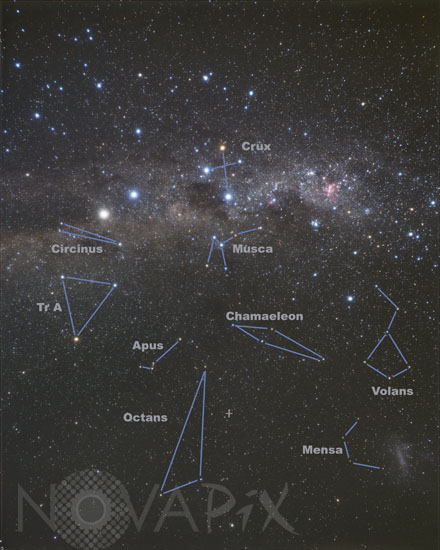Photo Agency - Astronomy - Space - Nature

The Southern Milky Way and south celestial pole
author: A.Fujii/David Malin Images/Novapix
reference: a-cst98-00005
Image Size 300 DPI: 40 * 51 cm
This part of the sky was mostly uncharted by Europeans until the 17th and 18th centuries, so many of the constellations in the southern (lower) half of the image are relatively modern constructions without mythlogical connotations. Octans, the Octant (a forerunner of the sextant) is an Enlightenment-period instrument whose outline was constructed on the sky by the vivid imagination of the Abbé Lacaille. The constellation is quite large but totally undistinguished. Its only notable feature is the South Celestial Pole, with is marked (within a degree or so) by the faint star s Octantis. Apus, the Bird of Paradise, first appeared in the star charts of the German astronomer Johann Bayer in 1603. It contains no named stars.
Chameleon, a type of lizard. The stars here are even fainter than those in Apus.
Mensa, the constellation was invented by de Lacaille to commemorate his sojourn at the Cape of Good Hope in the 1750s. The original name was Mons Mensa, Latin for Table Mountain. Its northern border crosses part of the Large Magellanic Cloud, possibly reminding Lacaille of the recurrent cloud over the mountain as seen from Cape Town. Musca, the Fly, is another undistinguished constellation that first appeared on Bayer's star charts in 1603.
Chameleon, a type of lizard. The stars here are even fainter than those in Apus.
Mensa, the constellation was invented by de Lacaille to commemorate his sojourn at the Cape of Good Hope in the 1750s. The original name was Mons Mensa, Latin for Table Mountain. Its northern border crosses part of the Large Magellanic Cloud, possibly reminding Lacaille of the recurrent cloud over the mountain as seen from Cape Town. Musca, the Fly, is another undistinguished constellation that first appeared on Bayer's star charts in 1603.
Keywords for this photo:
ALPHA CENTAURI - APUS - ASTRONOMY - CHAMAELEON - CIRCINUS - COAL SACK - CONSTELLATION - CRUX - ETA CARINAE - GALAXY - LARGE MAGELLANIC CLOUD - LINE - MAP - MENSA - MILKY WAY - MUSCA - NEBULA - NGC 3372 - OCTANS - POSTER - SOUTH CELESTIAL POLE - SOUTHERN CROSS - SOUTHERN HEMISPHERE - STAR - TRIANGULUM AUSTRALE - VOLANS -
Contact : Stéphane Aubin +33-(0)9-51-26-53-76
© Novapix - All rights reserved


